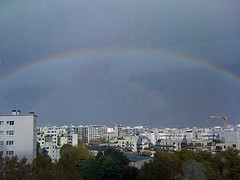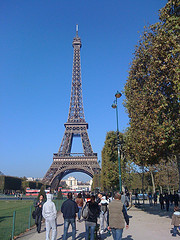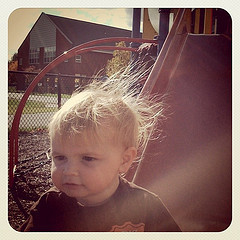Rachel Barenblat's Blog, page 238
November 3, 2011
A blessing for board elections
Both the synagogue which I serve as rabbi, and the Organization for Transformative Works where I serve as a Board member, are having Board elections this month. In light of this confluence, I offer the following.
May our hearts open to one another and to the community we strive to serve.
May we be kind to one another.
May we give one another benefit of the doubt.
May we listen to one another generously.
May we be willing, when it is appropriate, to set aside our own desires in the service of consensus.
May we be willing, when it is appropriate, to stand up for what we know to be right -- without diminishing the esteem with which we hold those with whom we disagree.
May we see the bigger picture of which we are all a part.
May we remember that there are things happening, in each person's life, to which we may not have access.
May we be compassionate with one another.
May we honor and thank those whose hard work has gotten us to where we are, and celebrate those who are willing to take the baton and continue the work ahead.
May all who serve reap joy.
And let us say: Amen!
November 2, 2011
Review, and poetry, in Seminary Ridge Review
I just got my copy of Seminary Ridge Review, issue 14:1, Autumn 2011, in which three of my poems appear. It's a beautiful magazine, published by Lutheran Theological Seminary. The Table of Contents contains articles including "A Contextual Reading of the Parable of the Persisisting Widow: An Indian Perspective" by Surekha Nelavala and "'Openness to the World:' Some Suggestions for Its Pastoral Bearings," by Leonard M. Humme, among othersl. (I am quite excited about reading all of these! There's a pdf available on the website, which includes all of this issue in full.)
The "Book Recommendations" section reviews of Mohja Kahf's E-mails From Scheherazad, of my collection 70 faces, and of Barbara Leff's And God Said: A Brief History of Creation. (I posted one of Mojha Kahf's poems here a few years ago; I'm looking forward to reading both of the books which were reviewed alongside mine.) The review of my book is gracious and generous. Here's a taste:
The book is infused with smoke, milk, blood, stars, curls of lemon, saddled donkeys, sinew, rafters hung with garlic, sand, apple skins, mountains. The scenes are well-set. The layout and forms support the narratives and the pacing for reading. The questions -- and there are plenty of questions -- are asked with the best sensitivity one could want in midrash explorations.
And then there's the "Poetry + Theology" section, which includes poems from Anne M. Higgins, Gary Fincke, Margaret Atwood, Paul David Steinke, Kathleen Rogers, Thomas Alan Holmes, and me. (I have three poems here: one Torah poem and two mother poems which are part of my as-yet unsold collection Waiting to Unfold.)
Deep thanks to the editors of Seminary Ridge Review; I'm honored to be included in this beautiful publication. (If you'd like to order a copy, individual copies are available for $9 per issue (includes domestic postage). Contact:
Seminary Ridge Press
Lutheran Theological Seminary at Gettysburg 61 Seminary Ridge
Gettysburg, PA 17325
(Or, just download the pdf on the journal's website.)
November 1, 2011
Profile in the Berkshire Jewish Voice
David Verzi, who interviewed me for the Berkshire Jewish Voice in December of 2006, back when I was in rabbinic school (Rachel Barenblat: "When Can I Run and Play with the Real Rabbis?") interviewed me again recently; I'm honored by his portrayal, and hope I can live up to his kind words. The article appears below for those who are interested. Thanks, David!
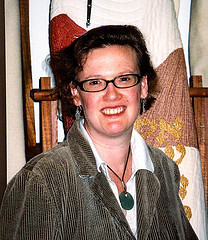
Photo by David Verzi.
Rabbi Rachel Barenblat: Light and Heat
By David Verzi
published in The Berkshire Jewish Voice, November 1 to December 1 2011 edition
By time honored custom, tradition and calling, a rabbi is sought to serve as a formal beacon of enlightenment and wisdom, this while much of modernity desires and demands that the illuminating insights of spiritual leaders come packaged within relaxed, comfortable, and comforting pew-side warmth.
These words with music, pedagogy with passion, light with heat combinations are no mean magic for a cleric to perform.
Fact is, it's no trick at all -- it's a feat melded with a gift.
For while the law, liturgy, and lessons that shed light can, through arduous scholarship, be attained for teaching: the heat, if authentic, must be childlike, filled with wonder, and heart-sprung.
At Congregation Beth Israel in North Adams, Rabbi Rachel Barenblat -- ordained by "ALEPH: the Alliance for Jewish Renewal" in January and installed on an interim basis by Beth Israel in July -- comprehensively emits the light via academic prowess, generated by near six years of rabbinic education and ongoing post-studies, a Bachelor of Arts in Religion from Williams College, and a Master in Fine Arts from Bennington College.
But, she "brings the heat," organically -- both through a clear-eyed, open-faced, grateful, articulate selflessness of character, wherein she seeks to find blessings in all things, and a bona fide love of her hundred-and-ten-family Reform congregation, within which, during the last ten years, Barenblat, 36, has played a critical role, as member, lay cantor, lay leader of services, and rabbinic student intern.
Even Barenblat's previous careers speak of light and heat -- a well-known area writer and editor, she is a master of factual communication but her forte is poetry rather than cold, hard facts. "With prayers, as with poems," Barenblat noted, "each word matters and each has the power to change something within us."
The light-giving-theologic-while-warmhearetedly-pastoral Barenblat is engagingly apparent during conversation, as questions and comments are first met with thought-pregnant pauses -- often accompanied by a classically sagacious and contemplative "hmmmmm" -- but thereafter responded to enthusiastically, joyfully, sensitively, and unequivocally.
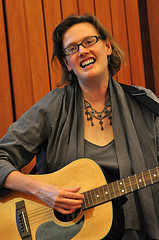
Rabbi Barenblat sings joyfully. Photo by Len Radin.
Of her first pulpit, Barenblat said she "wasn't nervous taking it," "was trained very well for it," and was able to "ease into it as a continuation and intensification" of her congregational duties of recent years.
However, married to Ethan Zuckerman and the mother of their son Drew, 2, Barenblat noted an initial "apprehension" regarding her ability to be "a working rabbi and the parent of a toddler" and the general "balance of work and family."
"My anxiety lay in: could I be a mother to Drew in the way I wanted to be and at the same time minister to the congregation the way I wanted to," said Barenblat, who noted that all has worked out fine even though her rabbinical position, designated as "half-time," nevertheless finds her trying to meet all of Beth Israel's needs.
Though trained and ordained within Judaism's Renewal tradition, which was founded by Rabbi Zalman Schachter-Shalomi in 1962, Barenblat noted she is a "perfect fit" for the Beth Israel community as the congregation, over its one-hundred-eighteen-year history, has been successively Orthodox, Conservative, and Reform and, more over, said Barenblat, "is a warm, open, and friendly" congregation.
Thus, noted Barenblat, as her Renewal training was "transdenominational" it will be "very useful in creating a worship life and community life that will feel like home to all."
To the benefit of Beth Israel, Barenblat noted, she has a high comfort level in expressing that "there is no single 'right' Jewish way to pray, study Torah, or conduct social action."
"So, I have the flexibility to try different things and see what resonates most for most of the community," said Barenblat, who with "storytelling" as a specific course within her Renewal training, might be seen -- rather than reading -- out amid her congregation telling a sacred story with an emphasis on dialogue and gesture; or, in contrast, this month, facilitating Beth Israel's first contemplative Shabbat service.
"My job is to create services that the congregation will respond to positively, and while hopefully that aligns with the services I want and need for my own spiritual life, the congregation comes first," said Barenblat, who noted that a rabbi is both a leader and a follower.
"On the one hand, I must hear what the congregants say is needed, yet, on the other, inspire the community to consider something more, something a little different, open them to exploring spiritual yearnings," said Barenblat. "If I go too far in the latter direction I risk not hearing them; if I don't go far enough I'm serving a consumerist model I don't believe in. Ministering to a congregation -- well, it just isn't exactly like selling someone a sofa! I may need to take your color and size preferences into account, but I also need to nudge you in a new direction."
Barenblat, aware of the criticism of the Reform movement as being so "wide open" as to be near "not standing for anything," acknowledged that certainly one of her challenges is to strike the right balance between tradition and innovation.
But looking at the fearless worship life of Rabbi Schachter-Shalomi, who ordained her and who she notes as a great inspiration, Barenblat said, "If our roots are deep enough, if we're really well planted, then our branches can be wide and there's nothing to fear."
Also having a profound effect on Barenblat's outlook was her stint, within her rabbinic training, as a chaplain at Albany Medical Center.
"It was extremely valuable because it involved interfaith work and because I had the opportunity to walk with people during their most glorious, wonderful moments and during their most tragic, terrible times," said Barenblat, who noted that the work "pulled her out" of herself.
"When you're sitting there in the emergency room with a woman whose son has just been hit by a car and it's not known if he'll live or die, all the things you might have been worrying about all day become 'little'; you're focused only on the person who is right there in front of you and in need of you," said Barenblat, who noted that other times all patients were looking for was a blanket, a glass of water, or a bit of conversation.
"But," recalled Barenblat, "another day I sat with a woman outside that emergency room who was cursing God with an eloquence that would make a sailor blush."
"Well, she looked at me expecting my correction. But I said 'I hear you,' and that was the comfort she needed -- to hear a clergyperson acknowledge her need under stress to curse God."
Once a counselor at a Jewish camp, Barenblat reminisced that it was always "the rabbinic pieces of the job" that she loved most -- "helping the kids learn to lead prayer services, and comforting them when they were homesick and needed to cry."
Bringing to bear her light and her heat to the benefit of others -- Barenblat's been at it for a long time.
October 31, 2011
Writing one's own deathbed prayer
It's a strange experience, writing one's own deathbed prayer.
The vidui is the confessional prayer which some recite every night before sleep, and some recite every weekday / non-festival morning during tachanun (the penitential prayers), and some recite every month during Yom Kippur Katan (the "little Day of Atonement" which precedes new moon), and some recite every year on Yom Kippur, and some recite before death. (I blogged about this, and especially about the bedtime prayer of forgiveness, earlier this fall: the vidui prayer of Yom Kippur...and of every night.)
The daily variant, the Yom Kippur variant, and the deathbed variant are slightly different -- but only slightly. In each of these, we reach out to God (whatever we understand that term to mean) and we ask forgiveness for our misdeeds and offer forgiveness to those who have hurt us, so that the karmic baggage of our actions won't follow us into the world to come.
There are classical texts for the deathbed vidui, and they are lovely. Here's one (from the Reform Rabbis' handbook:)
My God and God of all who have gone before me, Author of life and death, I turn to You in trust. Although I pray for life and health, I know that I am mortal. If my life must soon come to and end, let me die, I pray, at peace. If only my hands were clean and my heart pure! I confess that I have committed sins and left much undone, yet I know also the good that I did or tried to do. May my acts of goodness give meaning to my life, and may my errors be forgiven. Protector of bereaved and the helpless, watch over my loved ones. Into Your hand I commit my spirit; redeem it, O God of mercy and truth.
But nothing says that one has to use the traditional text. So as part of the Sage-ing class I'm taking (in my final months of the ALEPH Hashpa'ah / Spiritual Direction program), I've been charged with writing my own vidui. My own deathbed confession. The prayer I imagine saying to God as I prepare myself to die.
On the one hand there's something more than a little surreal about this. I don't expect death to be coming for me soon; how can I honestly write a deathbed prayer when I have no intention of dying in the next several decades at least? But on the proverbial other hand, there's no telling when death will knock on one's door. We read in the Babylonian Talmud that Rabbi Eliezer declared: "Repent one day before your death," whereupon his disciples asked: How does one know which day that is? "Exactly," answered the sage. "For that reason, we ought to live our lives each day as though it were our last."
Writing one's own vidui is a way of following Rabbi Eliezer's advice, a way of making teshuvah (repetance / returning-to-God) one day before my death. And if I do not die tomorrow, as I sincerely hope not to do, then tomorrow I will be tasked with making teshuvah again. And again. And again. Preparing for dying in this way, I think, is really a way of choosing how to live.
So I've drafted my vidui. Per my teachers' suggestions, I will keep it, and will aim to update it over the years as needed and as my life changes. In it, I address God in the ways which are most meaningful for me; I thank God for my life and my relationships; I ask forgiveness for the places where I have missed the mark, and express my intention to let go of my regrets so that they will not encumber me wherever I am going. I close by asking God to help me release this life and to help me through the contractions of the dying process, contractions which will release me into something I cannot now imagine, something none of us can know.
Writing it was a powerful experience for me. Imagining reading it at my own death, or perhaps hearing it read by a loved one if I am not able to read it myself, is equally powerful. What an amazing meditation.
This is part of what I'm finding most meaningful about the Sage-ing work I am beginning to learn to do: the way it takes the daily and weekly and monthly and annual cycles of teshuvah and stretches them to span an entire lifetime. Over the course of my whole life, what will sustain me? Where will I miss the mark? What will I need to forgive, and for what will I hope that others can forgive me? How will I want to take my leave of the life that I have known?
October 30, 2011
Contemplative chant-based Shabbat
This coming Shabbat morning, we're trying something new at my shul -- a contemplative chant-based Shabbat morning service. (What do I mean by that? Learn more.) This is a kind of davenen I discovered when I first encountered Jewish Renewal; it is one of many different modes of Jewish prayer, and it is one that I particularly love. I don't think we've ever done a service quite like this one at my shul, so it will be a new experience for most of our daveners. I'm looking really forward to it.
I've recorded about a dozen short chants which we'll be using in our Shabbat morning prayer next week. The chants follow the classical matbeah tefilah, the flow / structure of the morning liturgy, but each one consists of just one or two lines from a given prayer. We'll chant each several times, letting the music and the meaning wash over us and through us, and then sit in silence for a few minutes to discover what unfolds in us during the silence which seals the sound.
I've put our chant liturgy online -- a dozen chants, Hebrew and transliteration and English translation and mp3s -- and I thought I'd share it here in case it's helpful to any of y'all. It is here: contemplative chants for morning prayer. Please feel free to use, to share, and to enjoy -- and if you're in our neck of the woods next Shabbat morning, please feel free to join us!
(Credit where it is due: many of these chants were written by Rabbi Shefa Gold and can be found, sung in her voice, on her website. Others are by Rabbi Jeff Roth of the Awakened Heart Project. If contemplative Judaism is something you're interested in, both of these rabbis are excellent teachers...)
October 29, 2011
Rainbow for Shabbat Noach
On Shabbat Noach -- having read, this morning, the verses wherein God promises Noah and his sons that the rainbow is the sign that God will never again destroy the world with flood -- I can't resist posting this photo, taken in Paris a few days ago:
Rainbow over the Left Bank.
(If you're looking for a good reading for this week's parsha, I recommend Reb Arthur Waskow's Rainbow Covenant Haftarah -- in bilingual pdf here, in English here.)
October 28, 2011
Davening hallel with Drew
I love davening Hallel in community with Drew.
The psalms of Hallel are recited -- sung, traditionally, to a variety of melodies -- on festivals, new moon, times of celebration. They're meant to be sung with great gusto and spirit. And sometimes, I find, groups of adults get self-conscious about that. We're not sure we know the tunes, or the Hebrew isn't as fluid as we want it to be, or we just feel a little bit silly about singing and dancing. We tend to be reserved in the presence of each other and the presence of God.
But when I have Drew in my arms -- as I did for the recitation of hallel on Shemini Atzeret last week -- I naturally sing with passion, and dance around the room, and twirl in circles, because it makes him laugh, and making him laugh is one of my greatest joys. When I'm singing to God with Drew, or singing with God to Drew (it feels like both at once) I lose any self-consciousness I might have otherwise had.
And I think the rest of the room does, a little bit, too. When there is a laughing toddler squealing with glee as his mama spins in circles while singing psalms, everyone in the room seems to smile more widely. Maybe seeing a child's unironic, unselfconscious joy helps us to connect with the psalms' motifs of praise more easily.
Singing Hallel last week -- dancing around the sanctuary, twirling my toddler in my arms -- I remembered other, earlier, moments in Drew's life (and in my life as a mother) when I have danced and davened with him: at the Shavuot retreat with Reb Zalman when Drew was just over six months old, at smicha students' week that same summer at Pearlstone, countless other times which didn't spark poems or blog posts but which remain in my memory even so.
I know that the day will come when he won't let me hold him anymore while I sing and pray. Already he squirms out of my arms after a while, wanting to run around the sanctuary, climb onto chairs, explore the world. Though he usually runs right back to me and raises his arms to be lifted and cuddled and danced around the room again, that won't always be true. It feels incredibly precious to me...and that, in turn, heightens my ability to daven the psalms of Hallel with deeper feeling.
This is, I think, one of the ways in which Drew is (as my previous spiritual director told me he would be) a deep spiritual teacher for me. Without Drew in my life, I would never have discovered how it feels to daven with my own child in my arms. One of the psalms of Hallel speaks about calling out to God from the narrow straits, and my experience of parenthood has taken me there; every time I sing min ha-meitzar karati Yah I think of postpartum depression. But when I sing lo ha-meitim y'hallelu Yah, "the dead cannot praise You" (but we can!), I know that the added dimensions of joy which motherhood has brought to me are also part of my ability to offer God praise.
(My deep thanks are due to Rabbi Pam Wax for leading our Shemini Atzeret service, which made it possible for me to attend as a davener and a mama rather than as "the rabbi." It is a joy to lead davenen, and it is also a joy to sit in the kahal with my son.)
October 27, 2011
Libenson on Judaism as remix
I just received the final print issue of Zeek in my mailbox. For nine years Zeek has published a beautiful hardcopy print issue, separate from but related to its online edition; from now on Zeek exists purely online, at zeek.forward.com. Anyway, the print issue is focused on education -- specifically "Jewish education in the Facebook era" -- and I thought this exerpt from one article, by Daniel J. Libenson, might resonate for those of y'all who are interested in transformative works and remix:
A remix is "an alternative version of a recorded song that is made from an original version" (Wikipedia May 2011.) A twenty-first century hip-hop artist might take an old Frank Sinatra tune and intercut it with hip-hop sounds and lyrics to create a contemporary sounding song that still retains some of the big band beauty of Sinatra's music. The effect is to create a new kind of big band / hip-hop sound, as well as to introduce young people to music they never would have listened to otherwise. A Jewish DJ named SoCalled has created two albums on the JDub Records label in which he remixes old Jewish music and creates fresh and compelling contemporary songs that feel anchored in the past.
Remixing is a time-honored Jewish tradition -- it explains how Judaism has changed throughout history. Rabbinic Judaism is essentially a remix of the preceding Temple-centered version (which itself included elements of the previous version, such as an emphasis on the kind of storytelling that dominated pre-Temple Israelite sources) and many elements of Greek thought that had been foreign to Temple Judaism. In their remix, the rabbis reached back to the time of the prophets -- emphatically part of Version 1.0 -- to claim their mantle of authority (the very first sentence of Pirke Avot, which talks about the transmission of the Torah, does not even mention the priests who had ruled over the Jewish people for the previous half millennium.)
...Judaism 4.0 will be a remix of elements of Version 3.0, Version 2.0, and Version 1.0, as well as many contemporary ideas and practices from non-Jewish sources.
This isn't a new idea, of course; the idea of a paradigm shift is a mainstay of the writings of Reb Zalman Schachter-Shalomi and Reb Arthur Waskow, among others. But I like framing the idea in the language of remix; and, of course, this puts me in mind of the ways in which -- as I've argued before -- fandom and Judaism are both communities centered around a kind of transformative work.
There and back again
It was good to go...
...and it is good to return!
(Drew actually has a cold, so we haven't been to any playgrounds since I came home, so this photo is from last week, before we left town, but the general point still stands -- I loved spending four days abroad with Ethan, and now I love being home with our little guy again.)
For those who are interested, photos from our four lovely days in Paris are here on flickr.
October 25, 2011
Thanks, SMH
Many thanks to the folks at my high school alma mater, Saint Mary's Hall, for their kind profile of me in the school's periodical publication The Shield! I get a tremendous kick out of seeing my high school yearbook photo juxtaposed with a photo of me from my installation as rabbi of Congregation Beth Israel.
SMH was a great place for me. Studying Latin with the teacher who inspired me to apply to Williams -- savoring English classes -- performing Shakespeare in the courtyard -- sipping hot tea made in a beaker when AP biology met early to give us more time for labwork -- singing "cheers, cheers for seniors' blue ties!"...I carry a lot of good memories from those years and that place.
I know I'm the eleventh ordained rabbi to come out of Williams. I don't know how many rabbis have come out of Saint Mary's Hall; I'm guessing that our numbers are relatively few! But one way or another it's lovely to feel appreciated by one of the places that shaped the person I continue to be.
(For those who are curious, the issue is online, here, on page 61.)
Rachel Barenblat's Blog
- Rachel Barenblat's profile
- 6 followers


